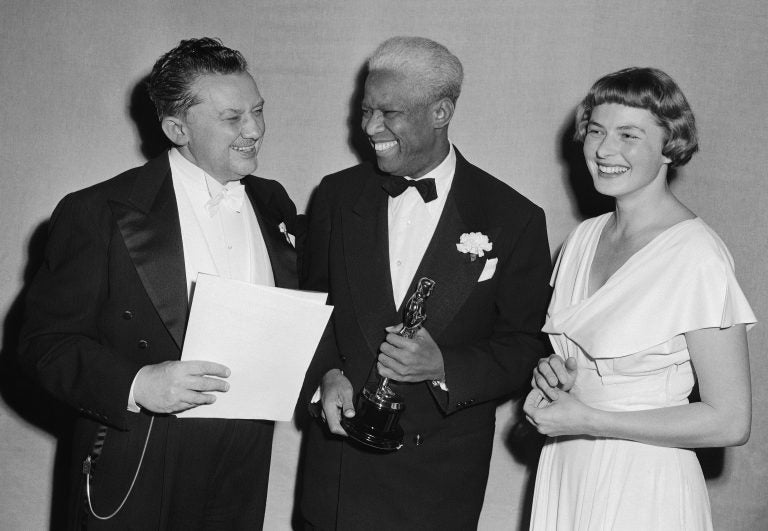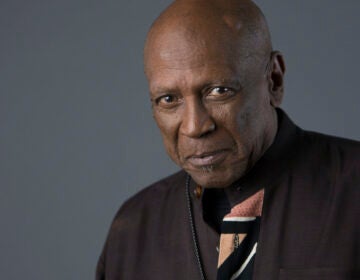The Jim Crow film that just won’t die, “Song of the South”
Racially segregated movie theaters disappeared decades ago but another element of the era just won’t die: Walt Disney’s 1946 movie “Song of the South.”

Jean Hersholt, from left, president of Academy of Motion Pictures Arts and Sciences, congratulates James Baskett, second African American to win an Oscar, for his special award for his portrayal of Uncle Remus in the 1946 Disney feature film "Song of the South" in Los Angeles, Calif. Looking on is Ingrid Bergman, who made presentation to Baskett. (AP Photo, File)
Racially segregated movie theaters and whites-only water fountains disappeared decades ago after court rulings struck down the legal framework of Jim Crow America, but another element of the era just won’t die: Walt Disney’s 1946 movie “Song of the South.”
With racist stereotypes and Old South tropes, the film isn’t available to the millions of subscribers of the company’s new Disney Plus streaming service, and it hasn’t been released in theaters in decades. Yet the movie, still beloved by many, lives on.
“Song of the South” is easily viewed on the internet either in whole or in pieces, and numerous websites offer versions of the movie or memorabilia for sale. Animatronic characters and music from the movie are even featured in a ride at Disney World in Orlando, Florida, minus the racist context.
The movie — a mix of live action, cartoons and music featuring an old black plantation laborer named Uncle Remus who enchants a white city boy with fables of talking animals — is like a zombie that keeps popping up seven decades after it was first released. While many find it racist and offensive, others see it as endearing.
“Yay! Have been looking for a good copy for years, kids really enjoyed it! Thank you,” a reviewer wrote recently on the online marketplace Etsy, where multiple versions of the movie are for sale.
Groups including the NAACP protested the film’s initial release, and arts professor Sheril Antonio said the continuing problem with “Song of the South” is that some just don’t see anything wrong with it.
“Most of the harm of all of this is not acknowledging our shared history, all the good and bad of it. The harm comes from ignoring it and not talking about it truthfully and fully,” Antonio, a senior associate dean of arts at New York University, said in an interview conducted by email.
Released the year after World War II ended, “Song of the South” premiered in Atlanta, where the Civil War epic “Gone With the Wind” made its debut a few years earlier. Set in post-Civil War Georgia, the Disney film featured stories that white newspaper writer Joel Chandler Harris heard from one-time slaves and published starting in 1876, according to The Wren’s Nest, Harris’ one-time home and now a museum in Atlanta.
Actor James Baskett was presented an honorary Academy Award for his portrayal of Uncle Remus, but the movie was perhaps best known for its Oscar-winning song “Zip-A-Dee-Doo-Dah.” The tune is part of the soundtrack at Disney World’s Splash Mountain ride, which also features Remus characters including Br’er Rabbit.
Yet while Disney Plus added a disclaimer to “Peter Pan,” “Dumbo”” and other vintage movies because they depict racist stereotypes, the company kept “Song of the South” locked away in its vault.
Disney last screened the movie in 1986, its 40th anniversary, despite years of complaints that it showed blacks as subservient to whites, and it never released “Song of the South” for home video sales in the United States. Foreign versions of the movie are among the editions available for sale on the internet.
“To be honest, I’ve lost track of how many people sell DVD bootlegs now,” said Christian Willis, who has run a website dedicated to the movie for about two decades.
Jason Sperb, who wrote a book about the movie and its legacy, said “Song of the South” received a lukewarm reception when it first opened but was a “huge hit” financially when it was released in the 1970s and ‘80s.
“Disney had become more of a cultural institution by then. All the old films, whether successful or not upon its original release, were now being rebranded as ‘classics,”’ said Sperb, author of “Disney’s Most Notorious Film: Race, Convergence, and the Hidden Histories of Song of the South.”
The continuing fascination that some have with the movie is likely more about the fact that Disney made it than its actual contents, he said in an email interview.
“I think if anyone else in Hollywood had made that movie it would have been almost completely forgotten about by today except for only the most hardcore animation history buffs who would note in passing its role in helping to shape the possibilities of hybrid animation,” said Sperb.
Willis, who runs the “Song of the South” website, said he was enamored with the movie after seeing it as a child in 1986 at age 6. He hopes the movie is released to the public again someday, and in the meantime he plans to keep adding to his online repository about the film.
“I think burying history is the wrong approach,” he said.
Some have reinterpreted old, racist films in a new way rather than simply screening them in their original format. Antonio, the NYU professor, cited DJ Spooky’s remix of the 1915 movie “Birth of a Nation,” which glorified the early Ku Klux Klan.
In “Rebirth of a Nation,” DJ Spooky (whose birth name is Paul D. Miller) trimmed the original film and applied new graphics and music he composed. In a live performance during the 2016 presidential campaign, he spliced together the original film with scenes from the civil rights movement and post-9/11 wars.
Antonio said she was “forever changed” by watching “Rebirth.”
“As you can see I am an educator, and in these cultural artifacts there is always value,” she said.
WHYY is your source for fact-based, in-depth journalism and information. As a nonprofit organization, we rely on financial support from readers like you. Please give today.



